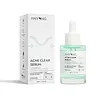What's inside
What's inside
 Key Ingredients
Key Ingredients

 Benefits
Benefits

 Concerns
Concerns

 Ingredients Side-by-side
Ingredients Side-by-side

Water
Skin ConditioningCentella Asiatica Leaf Extract
Skin ConditioningBacillus
Skin ConditioningAzelaic Acid
BufferingPropylene Glycol
HumectantAloe Barbadensis Leaf Juice
Skin ConditioningSodium Hyaluronate
HumectantPentylene Glycol
Skin ConditioningSalix Alba Bark Extract
AstringentPanthenol
Skin ConditioningMadecassic Acid
Skin ConditioningAsiaticoside
AntioxidantAsiatic Acid
Skin ConditioningInulin
Skin ConditioningFructose
HumectantHydroxyethylcellulose
Emulsion Stabilising1,2-Hexanediol
Skin ConditioningCaprylyl Glycol
EmollientSorbitol
HumectantSpirulina Platensis Extract
Skin ProtectingPotassium Sorbate
PreservativeEthylhexylglycerin
Skin ConditioningWater, Centella Asiatica Leaf Extract, Bacillus, Azelaic Acid, Propylene Glycol, Aloe Barbadensis Leaf Juice, Sodium Hyaluronate, Pentylene Glycol, Salix Alba Bark Extract, Panthenol, Madecassic Acid, Asiaticoside, Asiatic Acid, Inulin, Fructose, Hydroxyethylcellulose, 1,2-Hexanediol, Caprylyl Glycol, Sorbitol, Spirulina Platensis Extract, Potassium Sorbate, Ethylhexylglycerin
Water
Skin ConditioningPropylene Glycol
HumectantAzelaic Acid
BufferingPanthenol
Skin ConditioningMelaleuca Alternifolia Leaf Extract
PerfumingSodium Hyaluronate
HumectantGlycyrrhiza Glabra Root Extract
BleachingCamellia Sinensis Leaf Extract
AntimicrobialHydroxyethylcellulose
Emulsion StabilisingGlycerin
HumectantSodium Benzoate
MaskingAllantoin
Skin ConditioningPotassium Sorbate
PreservativePEG-40 Hydrogenated Castor Oil
EmulsifyingTetrasodium EDTA
Phenoxyethanol
PreservativeBenzoic Acid
MaskingDehydroacetic Acid
PreservativeSodium Hydroxide
BufferingWater, Propylene Glycol, Azelaic Acid, Panthenol, Melaleuca Alternifolia Leaf Extract, Sodium Hyaluronate, Glycyrrhiza Glabra Root Extract, Camellia Sinensis Leaf Extract, Hydroxyethylcellulose, Glycerin, Sodium Benzoate, Allantoin, Potassium Sorbate, PEG-40 Hydrogenated Castor Oil, Tetrasodium EDTA, Phenoxyethanol, Benzoic Acid, Dehydroacetic Acid, Sodium Hydroxide
 Reviews
Reviews

Ingredients Explained
These ingredients are found in both products.
Ingredients higher up in an ingredient list are typically present in a larger amount.
Azelaic acid is a multitasker ingredient that helps treat acne, pigmentation, and irritation. It is a great option for sensitive skin.
What makes azelaic special?
The best thing about azelaic acid is it's gentleness. It's generally well-tolerated and safe to use alongside other actives like niacinamide or salicylic acid.
Unlike AHAs, azelaic acid will not make you photosensitive/sun sensitive.
You can find this ingredient naturally occurring in grains like wheat, rye, and barley. In cosmetics, azelaic acid is typically lab-made, which is more stable and effective.
Learn more about Azelaic AcidHydroxyethylcellulose is used to improve the texture of products. It is created from a chemical reaction involving ethylene oxide and alkali-cellulose. Cellulose is a sugar found in plant cell walls and help give plants structure.
This ingredient helps stabilize products by preventing ingredients from separating. It can also help thicken the texture of a product.
This ingredient can also be found in pill medicines to help our bodies digest other ingredients.
Learn more about HydroxyethylcellulosePanthenol is a common ingredient that helps hydrate and soothe the skin. It is found naturally in our skin and hair.
There are two forms of panthenol: D and L.
D-panthenol is also known as dexpanthenol. Most cosmetics use dexpanthenol or a mixture of D and L-panthenol.
Panthenol is famous due to its ability to go deeper into the skin's layers. Using this ingredient has numerous pros (and no cons):
Like hyaluronic acid, panthenol is a humectant. Humectants are able to bind and hold large amounts of water to keep skin hydrated.
This ingredient works well for wound healing. It works by increasing tissue in the wound and helps close open wounds.
Once oxidized, panthenol converts to pantothenic acid. Panthothenic acid is found in all living cells.
This ingredient is also referred to as pro-vitamin B5.
Learn more about PanthenolPotassium Sorbate is a preservative used to prevent yeast and mold in products. It is commonly found in both cosmetic and food products.
This ingredient comes from potassium salt derived from sorbic acid. Sorbic acid is a natural antibiotic and effective against fungus.
Both potassium sorbate and sorbic acid can be found in baked goods, cheeses, dried meats, dried fruit, ice cream, pickles, wine, yogurt, and more.
You'll often find this ingredient used with other preservatives.
Learn more about Potassium SorbatePropylene Glycol is an odorless, colorless liquid. As a humectant, it helps skin retain moisture. It also aids in delivering active ingredients.
Another role of this ingredient is preventing a product from melting or freezing. Propylene glycol also adds antimicrobrial properties to a product, elongating product lifespan.
This ingredient is considered an organic alcohol and commonly added into both cosmetics and foods.
Those with sensitive skin or conditions may develop a rash when using this ingredient.
Learn more about Propylene GlycolSodium Hyaluronate is hyaluronic acid's salt form. It is commonly derived from the sodium salt of hyaluronic acid.
Like hyaluronic acid, it is great at holding water and acts as a humectant. This makes it a great skin hydrating ingredient.
Sodium Hyaluronate is naturally occurring in our bodies and is mostly found in eye fluid and joints.
These are some other common types of Hyaluronic Acid:
Learn more about Sodium HyaluronateWater. It's the most common cosmetic ingredient of all. You'll usually see it at the top of ingredient lists, meaning that it makes up the largest part of the product.
So why is it so popular? Water most often acts as a solvent - this means that it helps dissolve other ingredients into the formulation.
You'll also recognize water as that liquid we all need to stay alive. If you see this, drink a glass of water. Stay hydrated!
Learn more about Water